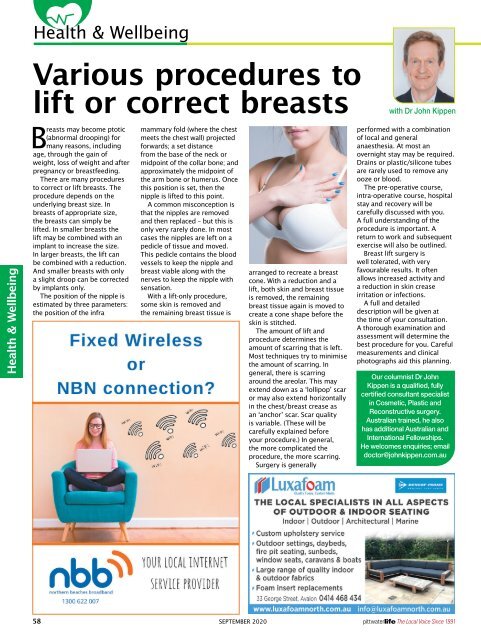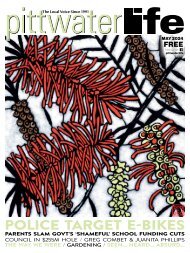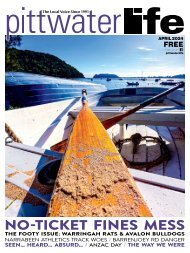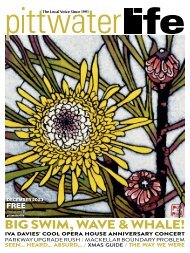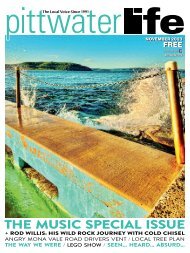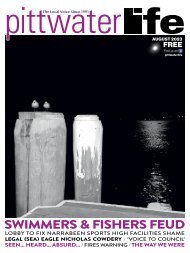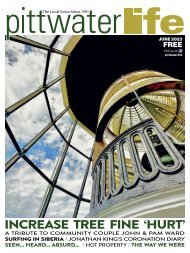Pittwater Life September 2020 Issue
OUR BEACHES ART PRIZE WINNERS. MUSO PAUL CHRISTIE: FROM ‘PARTY BOY’ TO ROCK ’N’ ROLL STORYTELLER. COVID CASUALTY: IS THE ENVIRONMENT. COPING WITH INCREASED WASTE? LOCAL PRINCIPAL SIGNS OFF / COUNCIL NEWS /SEEN... HEARD... ABSURD...
OUR BEACHES ART PRIZE WINNERS. MUSO PAUL CHRISTIE: FROM ‘PARTY BOY’ TO ROCK ’N’ ROLL STORYTELLER. COVID CASUALTY: IS THE ENVIRONMENT. COPING WITH INCREASED WASTE? LOCAL PRINCIPAL SIGNS OFF / COUNCIL NEWS /SEEN... HEARD... ABSURD...
- No tags were found...
Create successful ePaper yourself
Turn your PDF publications into a flip-book with our unique Google optimized e-Paper software.
Health & Wellbeing<br />
Health & Wellbeing<br />
Various procedures to<br />
lift or correct breasts<br />
Breasts may become ptotic<br />
(abnormal drooping) for<br />
many reasons, including<br />
age, through the gain of<br />
weight, loss of weight and after<br />
pregnancy or breastfeeding.<br />
There are many procedures<br />
to correct or lift breasts. The<br />
procedure depends on the<br />
underlying breast size. In<br />
breasts of appropriate size,<br />
the breasts can simply be<br />
lifted. In smaller breasts the<br />
lift may be combined with an<br />
implant to increase the size.<br />
In larger breasts, the lift can<br />
be combined with a reduction.<br />
And smaller breasts with only<br />
a slight droop can be corrected<br />
by implants only.<br />
The position of the nipple is<br />
estimated by three parameters:<br />
the position of the infra<br />
mammary fold (where the chest<br />
meets the chest wall) projected<br />
forwards; a set distance<br />
from the base of the neck or<br />
midpoint of the collar bone; and<br />
approximately the midpoint of<br />
the arm bone or humerus. Once<br />
this position is set, then the<br />
nipple is lifted to this point.<br />
A common misconception is<br />
that the nipples are removed<br />
and then replaced – but this is<br />
only very rarely done. In most<br />
cases the nipples are left on a<br />
pedicle of tissue and moved.<br />
This pedicle contains the blood<br />
vessels to keep the nipple and<br />
breast viable along with the<br />
nerves to keep the nipple with<br />
sensation.<br />
With a lift-only procedure,<br />
some skin is removed and<br />
the remaining breast tissue is<br />
arranged to recreate a breast<br />
cone. With a reduction and a<br />
lift, both skin and breast tissue<br />
is removed, the remaining<br />
breast tissue again is moved to<br />
create a cone shape before the<br />
skin is stitched.<br />
The amount of lift and<br />
procedure determines the<br />
amount of scarring that is left.<br />
Most techniques try to minimise<br />
the amount of scarring. In<br />
general, there is scarring<br />
around the areolar. This may<br />
extend down as a ‘lollipop’ scar<br />
or may also extend horizontally<br />
in the chest/breast crease as<br />
an ‘anchor’ scar. Scar quality<br />
is variable. (These will be<br />
carefully explained before<br />
your procedure.) In general,<br />
the more complicated the<br />
procedure, the more scarring.<br />
Surgery is generally<br />
with Dr John Kippen<br />
performed with a combination<br />
of local and general<br />
anaesthesia. At most an<br />
overnight stay may be required.<br />
Drains or plastic/silicone tubes<br />
are rarely used to remove any<br />
ooze or blood.<br />
The pre-operative course,<br />
intra-operative course, hospital<br />
stay and recovery will be<br />
carefully discussed with you.<br />
A full understanding of the<br />
procedure is important. A<br />
return to work and subsequent<br />
exercise will also be outlined.<br />
Breast lift surgery is<br />
well tolerated, with very<br />
favourable results. It often<br />
allows increased activity and<br />
a reduction in skin crease<br />
irritation or infections.<br />
A full and detailed<br />
description will be given at<br />
the time of your consultation.<br />
A thorough examination and<br />
assessment will determine the<br />
best procedure for you. Careful<br />
measurements and clinical<br />
photographs aid this planning.<br />
Our columnist Dr John<br />
Kippen is a qualified, fully<br />
certified consultant specialist<br />
in Cosmetic, Plastic and<br />
Reconstructive surgery.<br />
Australian trained, he also<br />
has additional Australian and<br />
International Fellowships.<br />
He welcomes enquiries; email<br />
doctor@johnkippen.com.au<br />
58 SEPTEMBER <strong>2020</strong><br />
The Local Voice Since 1991


